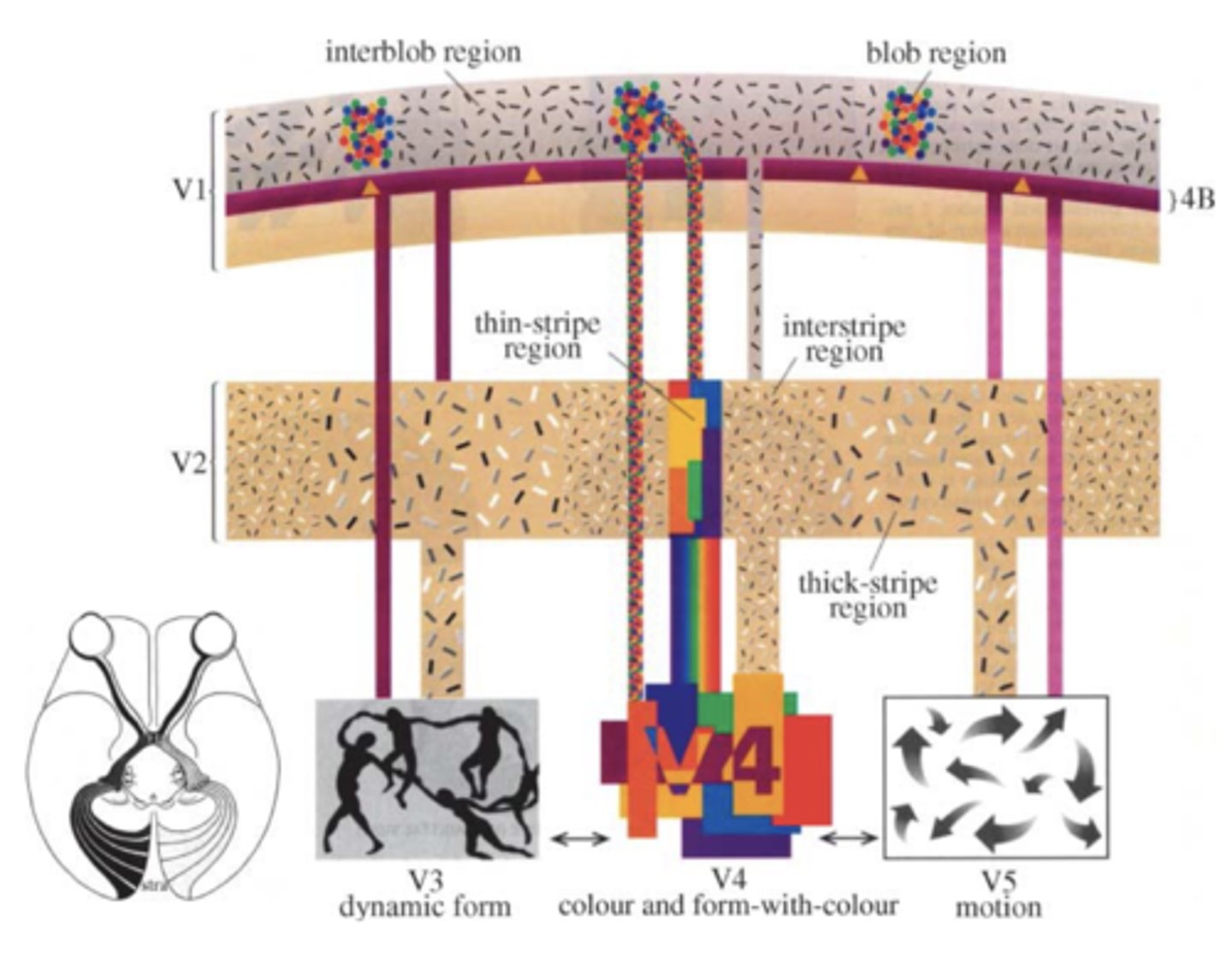Occipital and temporal lobe: visual perception and memory (L9)
1/13
There's no tags or description
Looks like no tags are added yet.
Name | Mastery | Learn | Test | Matching | Spaced |
|---|
No study sessions yet.
14 Terms
Hierarchy and functional differentiation in visual information processing
- Processing of visual information by brain is hierarchical → complexity of visual representation increasing from retina to visual association cortices and beyond.
- At different stages of information processing there is functional differentiation, with different neuron types or different brain regions processing different properties of visual stimuli.
Hierarchy and functional differentiation in visual information processing 2
- Simple features: light intensity and wavelength; 2D position in visual field → info combined and elaborated via parallel channels.
- Leads to more complex visual representations for perception and memory:
- Integrated information concerning form, surface (colour, texture), spatial relationships and movement.
- Integration with other sensory modalities (multimodal representations).
Visual information processing in extrastriate cortex
- Info gets through extra striate areas in occiptal lobe.
- Some distributed dorsally into parietal cortex and some down a pathway leading to the inferior temporal lobe.
- P

Visual processing in extrastriate cortex
- Neurons in extrastriate cortex signal 'global' properties of visual scenes and objects, rather than ' component' properties.

Global colour vs. component wavelength
- Perceived colour of an object depends not only on the wavelength reflected by object, but also on the wavelength reflected by the surroundings (colour constancy, e.g. perceived colour of object does not change when viewed during sunset).
- Some neurons in V4 are 'colour-sensitive' whereas neurons in primary visual pathway and V2 are only 'wavelength-sensitive'.
Global/pattern motion vs. component motion
- Component motion: when an object is moving towards 3 o'clock, cells with small receptive fields which 'look' at limited regions of the stimulus will register the component movements in different directions.
- Global motion: directionally selective cells of area V1 register the component directions whereas those of area V5, which 'look' at larger parts of the field of view, register the true, overall direction.

Two visual information processing streams
- Following V1, visual information processing seems to be mediated by two streams (anatomically and functionally differentiated).
- Dorsal stream: visuo-spatial/visuo-motor information (where and how).
- Ventral stream: object analysis (what).
Visual streams (what/where)
- Inferior temporal lobe lesions (ventral stream): in macaques (monkeys) impair object discrimination (what) but not object location (where).
- Posterior parietal lesions (dorsal stream): impair object location (where) but not discrimination (what).
Visual streams (what/how)
Milner and Goodale:
- Ventral stream processes visual information for object perception (what).
- Dorsal stream processes visual information for visuo-spatially guided action (how).
- Patients with occipito-temporal brain damage show severe forms of visual agnosia (i.e. deficits in aspects of visual perception without blindness) but intact visually guided actions.
- Patients with posterior-parietal lobe lesions show optic ataxia (i.e. deficits in visually guided reaching) with otherwise relatively intact visual function.
Patient DF
- Extensive bilateral ventral-stream lesions has profound visual agnosia, but shows intact visually guided reaching.
- Temporal damage; had trouble matching orientation of card slot, but no trouble putting card through a slot ('what' pathway affected, 'how' pathway fine).

Visual perception and memory in inferior temporal cortex
- Inferior temporal cortex receives inputs from extrastriate cortex and forms final stage in visual processing hierarchy of ventral stream.
- Neurons in inferior temporal cortex can respond very selectively to specific shapes and objects.
- Response can show: invariance to changes in size, orientation and other properties (i.e. the neuron 'recognises' object regardless of viewpoint).

Face cells
- Some neurons in the inferior temporal love show highly selective responses to individual faces.
- Highly selective properties have been compared to 'gnostic units' or 'grandmother neurons' (i.e. hypothetical neurons at the end of a processing hierarchy that 'recognise' individual entities (although face cells typically respond to several faces).
- Areas showing selective responses to faces have also been identified in the human inferior temporal lobe using functional imaging.

Medial temporal lobe (MTL): further processing of visual information and multimodal integration
- MTL at end of visual-processing hierarchy, combining inputs from ventral and dorsal stream, and receives additional inputs from other sensory modalities.
- Can elaborate visual representations further and generate multi-modal representations.

Examples of complex representations mediated by MTL structures
- Complex spatial representations, requiring the encoding of relations between many visual stimuli (e.g. encoding a certain spatial location by remembering that it was somewhere in between a desk, projector and wall).
- Multimodal representations of experiences (episodic memory) and facts (semantic memory) → together referred to as declarative memory (e.g. remembering the nice tasting food you had in a restaurant yesterday evening; memory of what the Queen of England looks and sounds like).